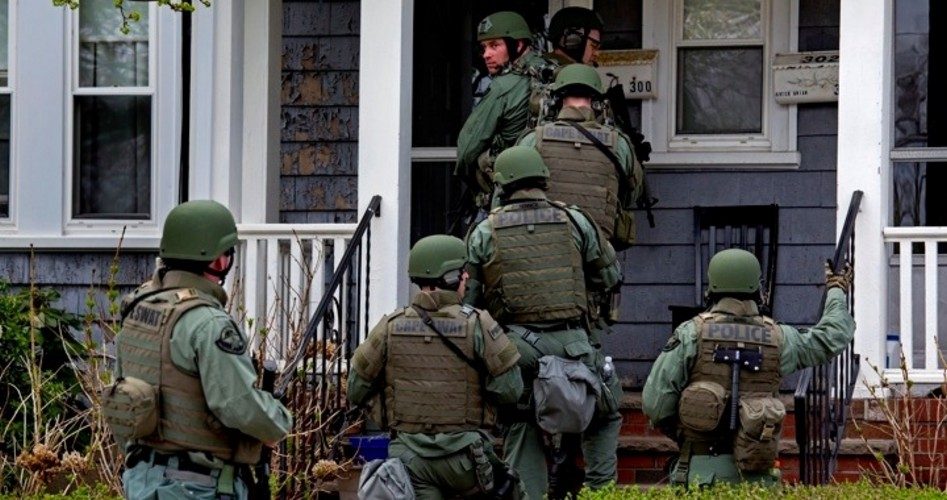
Only after the curfew in Watertown, Massachusetts, was lifted and alert resident David Hanberry went outside his home to get a smoke, according to news reports, did the case of the Boston Marathon bombing manhunt for suspect Dzhokhar Tsarnaev crack open. That was when Hanberry saw blood on the tarp of his dry-docked boat and called the police.
Up until that time, a wide assortment of local, state, and federal officials were engaged in a dragnet that essentially shut down the city of Boston, and included house-to-house searches in the neighborhoods of Watertown, Mass. and New Bedford, Mass., the latter being near where 19-year-old Russian immigrant Dzhokhar Tsarnaev had enrolled in college. Tsarnaev, a Muslim from the Dagestan area of Russia that abuts Chechnya, became a U.S. citizen on September 11 of last year.
In essence, the lessons from the Boston Marathon mean that the following procedures employed in the week-long manhunt proved to be completely ineffective in apprehending Tsarnaev:
• House-to-house searches in a dragnet-style;
• Use of military-style helicopters across the state;
• Use of tanks and armored vehicles on the streets of Boston, Cambridge, Watertown, and New Bedford;
• Shutting down the city, except for limited coffee shops;
• Stopping all public transportation;
• Banning taxi service across the city of Boston; and
• Abandoning the federal Posse Comitatus law banning the use of soldiers in law enforcement.
Moreover, the use of curfews in a number of towns actually likely delayed apprehension of the suspect, as the curfew essentially took more than a million pairs of eyes off possible getaway scenes.
Veteran police investigators have traditionally rejected the dragnet because they see it as a waste of police resources, but in the post-bombing panic, politicians demanded that police on the beat appear to be doing everything they could to solve the crisis. In this case, that appearance included a curfew that amounted to searching and hassling people who were clearly not in cahoots with the bombing suspects. Police detained and searched anyone on the streets of Boston and Watertown, even searching famous local news reporters multiple times during the course of the manhunt. In some instances, news reporters received death threats from over-zealous police officers.
In the end, if the goal of the terrorists was to terrorize, the terrorists won in Boston. Rather than returning to its ordinary business, one of the world’s greatest cities was terrorized, and even shut down, for days by the two suspects identified by authorities as Dzhokhar Tsarnaev and his older (deceased) brother Tamerlan. The two presumably hated America for its freedom, and were able to get the government to take away much of those freedoms from its citizens for a period of time.
The scare even led to a humorous over-reaction in Bridgewater, a college town where a “suspicious” backpack forced the evacuation of part of Bridgewater University. The Navy bomb disposal team arrived to find the backpack full of beer, according to the Brockton, Mass.-based Enterprise newspaper. The newspaper story did not record how police disposed of the “suspicious package.”
The reaction of Massachusetts’s state and federal officials to the Boston Marathon bombings — two black powder bombs with nails and ball bearings that killed three people — can be contrasted with the wave of 125 nearly identical bombings, technologically speaking, that took place across America in major U.S. cities during the 1917-20 “Red Scare.” The differences are that many more were killed 100 years ago, top U.S. government officials were targeted (including the U.S. Attorney General and judges) back then, and the federal government did not shut down entire cities. Although the period is known as the “Red Scare,” the genuine security threat was greater than the threat authorities responded to in Boston. And with the exception of a set of warrantless searches by the Justice Department’s Bureau of Investigation (later the FBI) under J. Edgar Hoover, the public’s liberties were respected.
And as if the attacks on civil liberties during the current Boston manhunt weren’t sufficient offense against the Bill of Rights, South Carolina Republican Senator Lindsay Graham has called on denying Dzhokhar Tsarnaev — a U.S. citizen — all his rights under the U.S. Constitution. On the evening of Tsarnaev’s arrest, Graham tweeted the following remarks:
• “If captured, I hope Administration will at least consider holding the Boston suspect as enemy combatant for intelligence gathering purposes.”
• “The Law of War allows us to hold individual in this scenario as potential enemy combatant w/o Miranda warnings or appointment of counsel.”
• “Under the Law of War we can hold #Boston suspect as a potential enemy combatant not entitled to Miranda warnings or appointment of counsel.”
Graham later tweeted a partial retraction, claiming: “As to any future trial, if this suspect is an American citizen, he is NOT subject to military commission trial. #Boston.”
However, that trial could (and probably should) be indefinitely delayed, according to Graham and Senator John McCain (R-Ariz.). The two issued a joint statement on April 20, arguing: “We hope the Obama Administration will consider the enemy combatant option because it is allowed by national security statutes and U.S. Supreme Court decisions.”
Photo of police performing a house-to-house search in Watertown, Mass., in the Greater Boston area: AP Images


